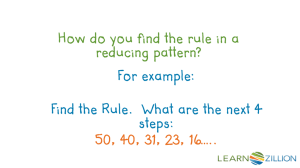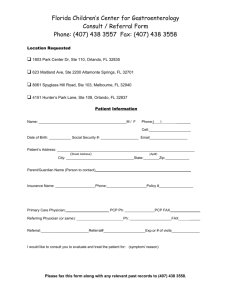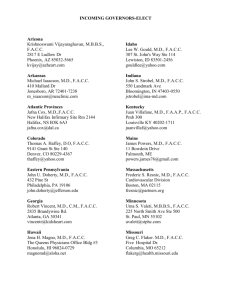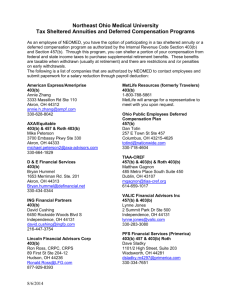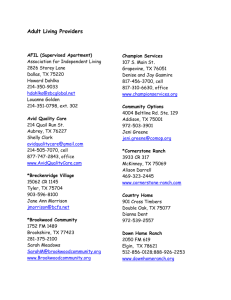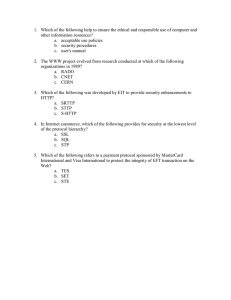GuidingPrinciples
advertisement
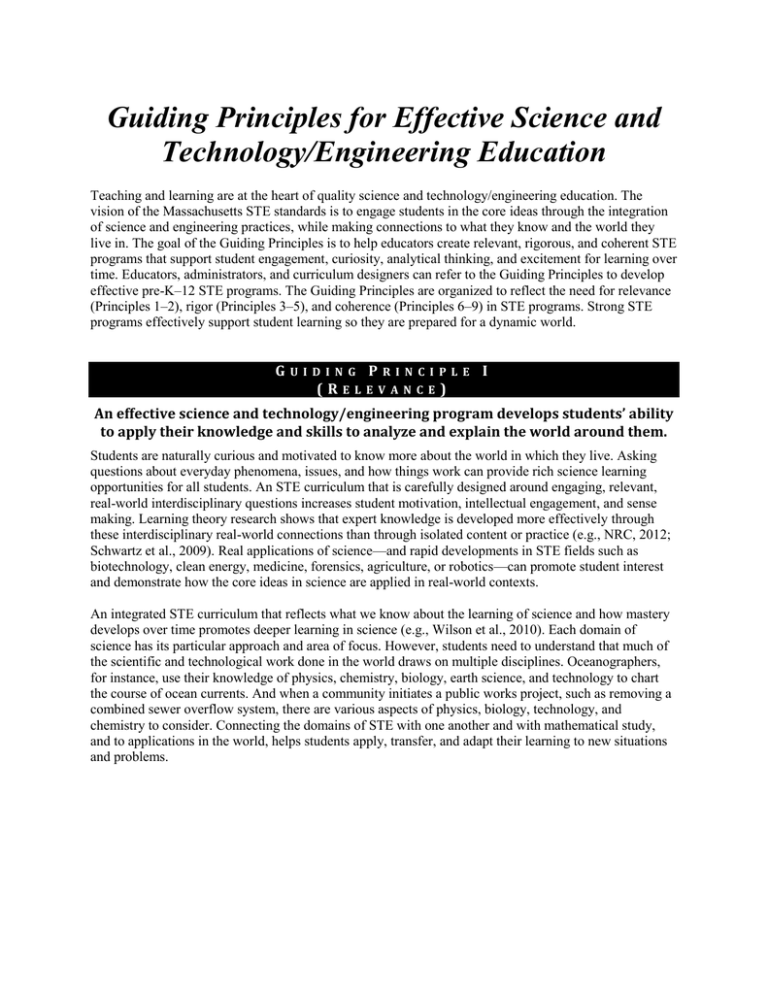
Guiding Principles for Effective Science and Technology/Engineering Education Teaching and learning are at the heart of quality science and technology/engineering education. The vision of the Massachusetts STE standards is to engage students in the core ideas through the integration of science and engineering practices, while making connections to what they know and the world they live in. The goal of the Guiding Principles is to help educators create relevant, rigorous, and coherent STE programs that support student engagement, curiosity, analytical thinking, and excitement for learning over time. Educators, administrators, and curriculum designers can refer to the Guiding Principles to develop effective pre-K–12 STE programs. The Guiding Principles are organized to reflect the need for relevance (Principles 1–2), rigor (Principles 3–5), and coherence (Principles 6–9) in STE programs. Strong STE programs effectively support student learning so they are prepared for a dynamic world. G U I D I N G P R I N C I P L E (RELEVANCE) I An effective science and technology/engineering program develops students’ ability to apply their knowledge and skills to analyze and explain the world around them. Students are naturally curious and motivated to know more about the world in which they live. Asking questions about everyday phenomena, issues, and how things work can provide rich science learning opportunities for all students. An STE curriculum that is carefully designed around engaging, relevant, real-world interdisciplinary questions increases student motivation, intellectual engagement, and sense making. Learning theory research shows that expert knowledge is developed more effectively through these interdisciplinary real-world connections than through isolated content or practice (e.g., NRC, 2012; Schwartz et al., 2009). Real applications of science—and rapid developments in STE fields such as biotechnology, clean energy, medicine, forensics, agriculture, or robotics—can promote student interest and demonstrate how the core ideas in science are applied in real-world contexts. An integrated STE curriculum that reflects what we know about the learning of science and how mastery develops over time promotes deeper learning in science (e.g., Wilson et al., 2010). Each domain of science has its particular approach and area of focus. However, students need to understand that much of the scientific and technological work done in the world draws on multiple disciplines. Oceanographers, for instance, use their knowledge of physics, chemistry, biology, earth science, and technology to chart the course of ocean currents. And when a community initiates a public works project, such as removing a combined sewer overflow system, there are various aspects of physics, biology, technology, and chemistry to consider. Connecting the domains of STE with one another and with mathematical study, and to applications in the world, helps students apply, transfer, and adapt their learning to new situations and problems. G U I D I N G P R I N C I P L E (RELEVANCE) II An effective science and technology/engineering program addresses students’ prior knowledge and preconceptions. Students are innately curious about the world and wonder how things work. They may make spontaneous, perceptive observations about natural objects and processes or designed objects and systems, and can often be found taking things apart and reassembling them. In many cases, students have developed mental models about how the world works. These mental models may be inaccurate or incomplete, even though they make sense to the students, and inaccuracies can hinder learning. Research show that children can hold on to misconceptions even while reproducing what they have been taught are the “correct answers.” They may find a variety of ingenious ways to reconcile their misconception with the correct knowledge. Teachers must be skilled at uncovering inaccuracies in students’ prior knowledge and observations, and in devising experiences that will challenge inaccurate beliefs and give students compelling reasons and evidence to redirect their learning along more productive routes. Instruction that addresses something students may wonder about or a discrepant event can inspire them to search for evidence and analyze information, to develop a reasonable explanation. Students’ natural curiosity provides one entry point for learning experiences designed to address students’ preconceptions in STE. Advancing student learning is not only about “fixing” misconceptions about individual concepts. It is about building and revising networks of concepts so students build interrelated ideas. A key assumption of the standards is that concepts and practices progress over time, becoming more sophisticated and scientific as students revise and reconceptualize their understandings. Recognizing that learners use their experiences and background knowledge to actively construct meaning helps educators effectively accommodate and address student prior knowledge and interests to enhance learning. G PRINCI (RIGOR) U I D I N G P L E III Investigation, experimentation, design, and analytical problem solving are central to an effective science and technology/engineering program. All students can develop proficiency in STE if instruction provides them with relevant and engaging opportunities. This includes a range of scientific investigations and thinking, including—but not limited to—inquiry and investigation, collection and analysis of evidence, analytical reasoning, and communication and application of information. Investigations introduce students to the nature of original research and design, increase students’ understanding of scientific and technological concepts, promote skill development, and provide entry points for all learners. Lessons should be designed so that knowledge and skills are developed and used together on a regular basis. Research shows that students learn when they have the opportunity to reflect on how the practices contribute to the accumulation of scientific knowledge. This means, for example, that when students carry out an investigation, develop models, articulate questions, or engage in arguments, they have opportunities to think about what they have done and why. Puzzlement and uncertainty are common features in experimentation. Students need time to examine their ideas as they apply them in explaining a natural phenomenon or solving a design problem. Opportunities for students to reflect on their own ideas, collect evidence, make inferences and predictions, and discuss their findings are all crucial to growth in understanding. These opportunities must be carefully chosen to link to important scientific ideas and give students ample time to generate and interpret evidence and develop explanations of the natural world through sustained investigations. It can also offer students an opportunity to monitor and evaluate their work. Through this kind of reflection and active processing, students understand the importance of each practice and develop a nuanced appreciation of the nature of science (also see Appendix VIII). G PRINCI (RIGOR) U I D I N G P L E IV An effective science and technology/engineering program provides opportunities for students to collaborate in scientific and technological endeavors and communicate their ideas. Scientists and engineers work as members of their professional communities. Ideas are tested, modified, extended, and reevaluated by those professional communities over time. Thus, the ability to convey ideas to others is essential for these advances to occur. In a classroom, student learning is advanced through social interactions among students, teachers, and external experts. In order to learn how to effectively communicate scientific and technological ideas, students require practice in making written and oral presentations, fielding questions, responding to critiques, and developing replies. Students need opportunities to talk about their work in focused discussions with peers and with those who have more experience and expertise. This communication can occur informally, in the context of an ongoing student collaboration or in an online consultation with a scientist or engineer, or more formally, when a student presents findings from an individual or group investigation. Opportunities to collaborate and communicate are critical to advance students’ STE learning. G U I D I N G (R P R I N C I P L E I G O R ) V An effective science and technology/engineering program conveys high academic expectations for all students. A high-quality education system simultaneously serves the goals of equity, excellence, and access for all students. At every level of the education system, teachers should act on the belief that young people from every background can learn rigorous STE content and engage in sophisticated analytical practices. Teachers and guidance personnel should advise students and parents that rigorous courses in STE at all grades will prepare them for success in college and the workplace, while elective and advanced courses can help them enter a STEM field, if that is their goal. After-school, weekend, and summer enrichment programs offered by school districts or communities may be especially valuable and should be open to all. Schools and districts should also invite role models from business and the community to visit classes, work with students, and contribute to STE instruction. Regardless of whether students go on to an institute of higher education or to a workplace, they should be equipped with the skills and habits required for postsecondary success. Skills, such as the ability to work through difficult problems, to be creative in problem solving, and to think critically and analytically, will serve students in any setting. The STE standards are designed to include three interrelated components necessary for such preparation: conceptual understanding of disciplinary core ideas, science and engineering practices, and application to the natural and designed world. These components are illustrated in this graphic: When students work toward high expectations in STE, they develop the foundations needed for success after graduation. G U I D I N G P R I N C I P L E (COHERENCE) VI An effective science and technology/engineering program integrates STE learning with mathematics and disciplinary literacy. Mathematics is an essential tool for scientists and engineers because it specifies in precise and abstract (general) terms many attributes of natural phenomena and human-made systems. Mathematics facilitates precise analysis and prediction through formulae that represent the nature of relationships among components of a system (e.g., F = ma). Mathematics can also be used to quantify dimensions and scale, allowing investigations of questions such as: How small is a bacterium? How large is a star? How dense is lead? How fast is sound? How hard is a diamond? How sturdy is the bridge? How safe is the plane? With such analyses, all kinds of intellectual and practical questions can be posed, predicted, and solved. In addition to mathematics, reading, writing, and communication skills are necessary elements of learning and applying STE (also see Guiding Principle IV). Teachers should consistently support students in acquiring comprehension skills and strategies to deepen students’ understanding of STE concepts as represented and conveyed in a variety of texts. Scientific and technical texts contain specialized knowledge that is organized in a specific way, including informational text, diagrams, charts, graphs, and formulas. For example, scientific texts will often articulate a general principle that describes a pattern in nature, followed by evidence that supports and illustrates the principle. STE classrooms make use of a variety of text materials, including scientific and technical articles, journals, lab instructions, reports, and textbooks. Texts are generally informational in nature, rather than narrative, and often include technical information related to a particular phenomenon, process, or structure. Students should be able to use a variety of texts to distinguish fact from opinion, make inferences, draw conclusions, and collect evidence to test hypotheses and build arguments. Teachers should help students understand that the types of texts students read, along with the reason(s) for reading these texts, are specific to STE. Supporting the development of students’ literacy skills will help them to deepen their understanding of STE concepts. Successful STE learning requires explicit opportunities to develop mathematics and disciplinary literacy knowledge and skills (also see Appendix II). G U I D I N G P R I N C I P L E (COHERENCE) VII An effective science and technology/engineering program uses regular assessment to inform student learning, guide instruction, and evaluate student progress. Teaching without attention to learners’ perspectives and prior knowledge is like flying a plane in fog without instruments. Ball & Forzani, 2012 Assessment reflects classroom expectations and shows outcomes of student learning based on established knowledge and performance goals. The learning standards in this Framework are a key resource for setting such knowledge and performance objectives in STE. Assessment assists teachers in improving classroom practice, planning curricula, developing self-directed learners, reporting student progress, and evaluating programs. It provides students with feedback about how their knowledge and skills are developing and what can be done to improve them. It lets parents know how well their children are doing and what needs to be done to help them do better. Diagnostic information gained from different types of assessment enables teachers to adjust their day-today and week-to-week practices to foster greater student achievement. There are many types of assessment, such as paper-and-pencil testing, performance assessments, interviews, and portfolios, as well as less formal inventories such as regular observation of student responses to instruction. Given the emphasis on science and engineering practices in the standards, performance-based assessments should be developed that allow students to demonstrate what they have learned in the context of real-world problems and applications. Learning progressions recognize that learning requires revision of networks of understanding, not revision of individual concepts (or misconceptions) (e.g., Alonzo & Gotwals, 2012; Corcoran et al., 2009; NRC, 2012). If teachers understand where their students are in their understanding of core ideas, and anticipate what students’ misconceptions and struggles may be (e.g., Driver et al., 1985, 1994; Keeley et al., 2005; Stanford University, 2012), they can better differentiate instruction and provide scaffolding that allows each student to develop an integrated and deeper understanding of the STE content. It is important to remember that the assessment of the standards should be on understanding the full disciplinary core ideas, not just the pieces in the context of practices. G U I D I N G (C PRINCIPLE O H E R E N C E ) VIII An effective science and technology/engineering program engages all students, preK through grade 12. Students benefit from studying STE throughout all their years of schooling. Appendix VI discusses the importance of science and engineering in early education. The standards are designed with coherent progressions of learning across time, recognizing that learning requires developing networks of ideas that develop and deepen over time. And the importance of science and engineering practices in the standards highlights the need to coordinate STE experiences over time (also see Appendix VII). Students should learn the fundamental concepts of each domain of STE, as well as the connections across those domains. A school district or educator can choose from many instructional models and curricular design approaches to effectively engage students in STE learning. One option (among these many) is Project-Based Learning (PBL), in which students go through an extended process of inquiry or design in response to an authentic question, problem, or challenge. They draw from many disciplines when understanding and addressing a complex problem. PBL is centered on student and teacher collaboration and application of academic knowledge and skills. While engaged in PBL, students are engaged in science and engineering practices, as well as cross-disciplinary concepts; students engage in reading and writing informational text and mathematics depending on the driving question of the project. A PBL approach allows for some student choice and voice that promotes motivation and educational equity. PBL includes a process of revision and reflection that requires students to learn how to communicate and receive instructive feedback and to think about their own cognition and understanding. The amount of time individual students need to achieve STE standards will vary. The chart below provides the time assumed to be provided for STE instruction by grade span to inform the standards development: Grade Span Assumed Minutes per Day (Hours per week) K–2 25 minutes/day (~2 hours/week) 3–5 35 minutes/day (~3 hours/week) 6–8 55 minutes/day (~4.5 hours/week) 9–12 65 minutes/day (~5.5 hours/week) Schools may take more or less time, depending on local factors that determine curriculum programming within a specific context. STE instruction may be a dedicated time in the school schedule or may be integrated with instruction of other subjects. The goal is for all students to have regular STE instruction every year. G U I D I N G P R I N C I P L E (COHERENCE) IX An effective science and technology/engineering program requires coherent districtwide planning and ongoing support for implementation. An effective curriculum that addresses the learning standards of this Framework must be planned as a cohesive pre-K–12 program. Teachers in different classrooms and at different levels should agree about what is to be taught in given grades. For example, middle school teachers should be able to expect that students coming from different elementary schools within a district share a common set of STE understandings and skills, and that the students they send on to high school will be well prepared for what comes next. In order for this expectation to be met, middle school teachers need to plan curricula in coordination with their elementary and high school colleagues and with district staff. To facilitate planning, a district coordinator or administrator should be involved in articulating, coordinating, and implementing a districtwide (pre-K–12) STE curriculum. School districts should choose engaging, challenging, and accurate curriculum materials that are based on research into how children learn STE, as well as research about how to address student preconceptions. When planning for the introduction of a new curriculum, it is important to explicitly identify how success will be measured. Indicators need to be determined and should be communicated to all stakeholders. Supervisors should monitor whether the curriculum is actually being used, how instruction has changed, and how student learning is being realized. Teacher teams, working across grade levels, should look at student work and other forms of assessment to determine whether there is evidence of achievement of the sought-for gains in student understanding. Implementation of a new curriculum is accomplished over multiple years and requires opportunities for extensive professional development. Teachers must have both content knowledge and pedagogical expertise to use curricular materials in a way that enhances student learning. A well-planned program for professional development provides for both content learning and content-based pedagogical training. It is further recommended that middle and high school courses be taught by teachers who are certified in their areas and who are, therefore, very familiar with the safe use of materials, equipment, and processes. Finally, students will be more likely to succeed in meeting the standards if they have the curricular and instructional support that encourages their interests in STE. Further, students who are motivated to continue their studies and to persist in more advanced and challenging courses are more likely to become STEM-engaged citizens and, in some cases, pursue careers in STEM fields. These affective goals should be an explicit focus of quality STE programs. References Alonzo, A. C., & Gotwals, A. W. (2012). Learning progressions in science: Current challenges and future directions. Rotterdam, The Netherlands: Sense Publishers. Ball, D. L., and Forzani, F. (2012). Teaching skillful teaching. Educational Leadership, 68(4), 40-45. Corcoran, T., Mosher, F., & Rogat, A. (2009). Learning progressions in science: An evidence-based approach to reform. CPRE Research Report #RR-63. Philadelphia: Consortium for Policy Research in Education. Driver, R., Guesne, E., & Tiberghien, A. (Eds.). (1985). Children’s ideas in science. Milton Keynes, UK: Open University Press. Driver, R., Squires, A., Rushworth, P., & Wood-Robinson, V. (1994). Making sense of secondary science. London, UK: Routledge. Keeley, P., Eberle, F., & Farrin, L. (2005). Uncovering student ideas in science (Volume 1): 25 formative assessment probes. Arlington, VA: National Science Teachers Association Press. National Research Council (NRC). (2012). A framework for K-12 science education: Practices, crosscutting concepts, and core ideas. Washington, DC: The National Academies Press. Schwartz, M. S., Sadler, P. M., Sonnert, G., & Tai, R. H. (2009). Depth vs breadth: How content coverage in high school science courses relates to later success in college science coursework. Science Education, 93, 798-826. Stanford University. (2012). Understanding language. Retrieved from http://ell.stanford.edu/teaching_resources Wilson, C., Taylor, J., Kowalski, S., & Carlson, J. (2010). The relative effects and equity of inquiry-based and commonplace science teaching on students’ knowledge, reasoning, and argumentation. Journal of Research in Science Teaching, 47(3), 276-301.
